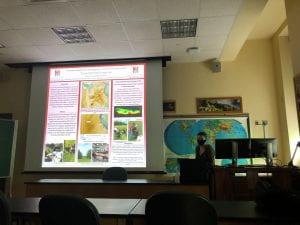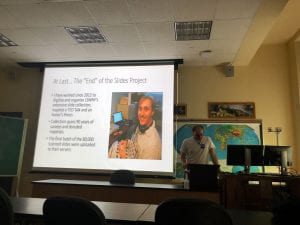This Wednesday, the 22nd, six of our Applied Archaeology graduate students at Indiana University of Pennsylvania presented at our monthly colloquium on What We Did This Summer/Recently. We heard from some amazingly talented students, eager to share their adventures and discoveries!
After a great introduction from Dr. Lara Homsey-Messer, Emma Frauendienst started us off with her presentation about her summer fieldwork at the Poverty Point World Heritage Site. Poverty Point, one of the largest Archaic Period sites in North America, is located in Louisiana. Her work, titled Downhole Geophysical Investigations of the West Plaza Rise at the Poverty Point World Heritage Site, began after receiving a grant, and facing both covid and flooding setbacks. Her team extracted 21 new soil cores, focusing on the West Plaza Rise to determine if it was a natural or constructed feature. After analysis of the cores and magnetic susceptibility data showing heavy cultural fill, it was determined that the West Plaza Rise was culturally constructed!
Mikala Hardie and Richard Farley then discussed their experiences as Graduate Assistants during IUP’s Newport Field School. Newport, a small shipping town located along the Conemaugh River, was occupied from around 1790 into the early 19th century. The excavation began with shovel test pits, ground penetrating radar, and several test units, before excavation units were opened. The woods crew, led by Mikala, worked to find the walls of the general store, while also uncovering artifacts such as, porcelain, faunal remains, mochaware, and a builder’s trench, to name a few. The field crew, supervised by Richard, focused on finding the blacksmith shop and hotel, along the way uncovering post holes, slag, redware, pearlware, creamware, and transfer printed earthenware, among other things. The field school utilized photogrammetry, magnetometry, GPS, and a total station to also collect valuable information about the site. If anyone wants to know more about what it’s like as a graduate assistant at a field school, just ask Mikala and Richard, who also filled out forms and logs, took lots of pictures, and organized and supervised those working at the site!
Ashley Nagle and Sonja Rossi-Williams presented next about their time spent as Graduate Assistants in Lower Saxony, Germany at IUP’s Forensic Field School! From July to mid-August, they worked at a World War 2 B-24 aircraft crash site! They used GPR to first define the sides of their 2X2, and then used shovels more than trowels to remove the soil in their units. The team learned about archaeological methods and practices used in Germany and took several excursions across Germany, including to Hannover, Berlin, and Munich, making this an incredible cultural experience as well as archaeological. They did not find what they were looking for, an unaccounted-for soldier, but they did make progress on the site itself. The team were even featured in a German newspaper! In the future, the site will most likely undergo more excavations, hopefully by IUP students!
Luke Nicosia was the final presenter, recounting his internship in July and August this summer with the Landmark Society of Western New York, a historic preservation agency. Founded in 1937, it is one of the oldest such societies in the US and seeks to advise property and homeowners on historic preservation planning and awareness, raise funding, and protect local historic sites. Luke conducted fee-for-service survey work and worked on their library projects. He edited site narratives and report drafts, finished reconnaissance on a survey on village properties, did covenant review, and worked in the library scanning and inventorying. He finished a massive slides project after scanning and digitizing over 80,000 slides over the course of many years (this is not his first time interning with the Landmark Society)! He also mentioned that there are many ways one can get involved in the field of historical preservation, many that align with the field of archaeology!
Thank you to all the presenters and everyone who attended our first colloquium of What We Did This Summer/Recently!



